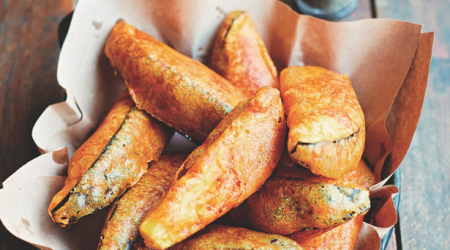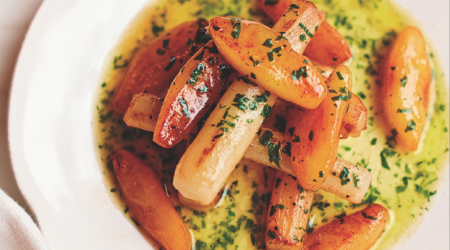Gascon Gastronomy
Pierre Koffmann has clocked up 50 years running the best restaurants in the country. From humble beginnings in Gascony, his elevated takes on French country cuisine revolutionised fine dining in London. Mark Sansom meets the man they call ‘The Bear’
It’s the day before the Rugby
World Cup Final and Pierre Koffmann feels like roast beef.
Arguably the greatest chef to
have ever lived and worked in
the UK arrived here for the first
time in 1970 to watch a rugby
match – England against
France in the Five Nations
– and has made London his
home since the final whistle.
On that day, France ran
out unlikely winners and
– such were the post-match
celebrations – Koffmann
decided to stay. With a solid
pedigree of restaurant
experience in Strasbourg and
Toulon behind him as well as
qualifications from a Gascony
cookery college, finding a job
in Seventies London would
not prove difficult.
‘The food here at the time was very strange,’ says Koffmann over coffee at a local café in north-west London where he takes breakfast every day with his wife, Claire. ‘It was extremely hard to find a good meal. There were hotel restaurants like the Savoy who would try to cook properly, but there just wasn’t the access to ingredients.’ There was, however, a growing appetite for quality food.
‘Every now and then you would be lucky enough to come across a reasonable restaurant, serving Italian or Indian food,’ says Koffmann. ‘These places were packed, so it was clear British people were beginning to understand what was good and not so good.’
One of Koffmann’s contacts from France put him in touch with Albert Roux, who had recently opened Le Gavroche in Mayfair. At the time, the UK’s best French restaurant was acting as a kind of finishing school for talented young French chefs. The Roux brothers Albert and Michel had noticed the potential that an authentic, stylised restaurant serving French haute cuisine would have in this corner of London. The restaurant would go on to be the first in the UK to gain three-Michelin-star status.
The Rouxs appreciated
Koffmann’s quiet work ethic and presence. A man with
shoulders like Marble Arch,
hands like dinner plates and
a gruff baritone that reverberates
today as it did 50 years ago,
the other chefs respected
Koffmann immediately. He
would later go on to earn the
nickname ‘The Bear’ from his
staff at La Tante Claire, ‘though,
they never called me that to
my face,’ he laughs.
SEEING STARS
His presence and prodigious palate saw him progress rapidly through at Le Gavroche. In 1972, the Rouxs asked him to become the head chef at The Waterside Inn, a restaurant they were opening in the small Berkshire hamlet of Bray. From the ground up, Koffmann transformed the dilapidated pub from a shell to one of England’s greatest restaurants. ‘It was a wonderful time,’ he says. ‘Once the locals got used to us and stopped putting paint on our car windows, they realised it might be good for the area.’
The food he was cooking then was similar to the food he cooked at Le Gavroche: classic French, made with the best produce he could access. ‘There were a few guys who would do runs back and forth in vans to France for ingredients,’ he says. ‘They were doing very good business. Much better than the restaurants, in fact. If I had the right things to cook, I knew a restaurant would work.’
‘I am not ready to finish yet. I miss the excitement, the noise and the passion of a successful kitchen. But it’s when everyone has left and I sit in the empty, silent restaurant that I really feel at home’
This reputation to make ingredients taste the purest incarnation of themselves has been with him since he landed in the UK. Michelin-starred Tom Kitchin – of The Kitchin in Edinburgh – who is one in a long line of successful alumnus from La Tante Claire – describes it best. ‘The man is a genius with ingredients. Koffmann could extract flavour from a crisp packet.’
It was clear very early on that Koffmann would not to remain in another chef’s employ for long. His work at The Waterside Inn was gathering column inches from the country’s top food writers and the reservations diary was soon full. The restaurant later reached three-star status in 1985 and, in 2010, became the first restaurant outside France to retain three stars for 25 years.
In 1977 the opportunity arose for a return to London. ‘I very much enjoyed my time in Bray. It was a beautiful little town, but I still felt I had a lot more to achieve,’ says Koffmann.
La Tante Claire gave him that
opportunity. With the style that hasn’t changed in his
half-century at the pass, he
started to create the artistic
French food that made his
name. ‘My style hasn’t changed
over the years, because I was
brought up with classical
modern French food,’ he says.
‘That’s what I like and that’s
what I like to cook. Japanese,
Chinese and all Asian food can
be truly fantastic, but it is not
my style. I like to stick with
what I’m good at.’
It was dishes such as his
pig’s trotter, which takes a part
of the animal generally
discarded and turns it into a
restaurant-defining dish, that
really saw him recognised.
While other restaurants would
rely on foie gras and truffle
(though La Tante Claire certainly
served those, too), these
elevated takes on Gascon
peasant food were what
would define his.
La Tante Claire received its third star six years after opening. It held all three until 1998, when, in an unusual move, Koffmann decided to move the entire restaurant team to a new location in The Berkeley hotel in 1999. At the time, Koffmann said that he wanted the new challenge a fresh kitchen environment would bring. The old La Tante Claire site in Chelsea was subsequently sold to Gordon Ramsay for his debut restaurant.
Moving a fine-dining
restaurant into a hotel offers
many benefits. The extreme
costs that go in to producing
three-star Michelin food can
be absorbed by the hotel
group, kitchen space is
generally more structured and
larger and there are fewer direct
overheads for the restaurateur
to pay. For the first year, La
Tante Claire 2.0 maintained its
three stars, though the following
year it dropped to two.
Koffmann made the decision to close in 2003, after the death
of his first wife, Annie.
He spent the next year travelling. He took in the Far East and Latin America, eating his way between Japan, China, Cuba and Mexico. ‘I ate insects, and intestines and watched animals killed before being eaten, but the strangest thing for me was staying in bed until 9am before my first cappuccino,’ he says. ‘I was so used to getting up at 4am that this kind of life where all you have to think about it is where you’re eating lunch just didn’t work.’
After a couple of years off where he tried to get into golf – ‘I liked it; it just didn’t like me’ – the offer came from Selfridges to take over its restaurant for a ten-day stint in 2009. He returned to the original recipes from La Tante Claire. Plates of pig’s trotters stuffed with chicken mousse and morels, salmon cooked in goose fat, brawn terrine and his legendary pistachio soufflé (above) flew out of the kitchen. Those ten days became four months and prompted his decision to look again for permanent digs.
Koffmann’s at The Berkeley opened in 2010, a return to the hotel he’d left seven years previously. Its six-year run ended in 2016 and Koffmann has not cooked in a single restaurant regularly since. Will he ever head his own place again? ‘I am not ready to finish yet. I miss working with young people – they give me energy. I miss the excitement, the noise and the passion of a successful kitchen,’ he says. ‘But it’s when everyone has left and I sit in the empty, silent restaurant that I really feel at home.’
Koffmann’s luck might not have been with the England rugby team in the World Cup Final, but with desire still coursing through him, there’s every chance that Le Coq will soon be back to roost.

Recipes
Get Premium access to all the latest content online
Subscribe and view full print editions online... Subscribe





